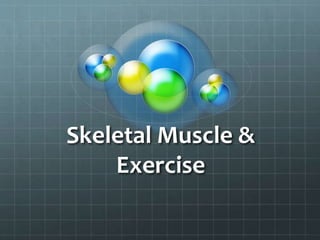
Exercise physiology 2
- 2. Muscle Fiber Type Classification Slow Twitch / Type I / Slow Oxidative Fast Twitch / Type II (IIa, IIx, IIc) / Fast Oxidative,Glycolytic / Fast Glycolytic
- 3. Recruitment order I IIa IIx IIc. On average most muscle composed of 50% type I, 25% type IIa, remaining 25% type IIx with type IIc making up 1 – 3% of the muscle. Exact percentage varies greatly in various muscles and amongst individuals.
- 4. Characteristics of Type I and Type II Fibers
- 5. ATPase Difference in speed of contraction results primarily from different forms of myosin ATPase. Myosin ATPase – enzyme that splits ATP to release energy to drive contraction. Type I – slow form Type II – fast form, allowing cross bridges to cycle more rapidly
- 6. Classification method Chemical Staining Gel Electrophoresis Histochemical method of identifying fibers by their primary isoforms.
- 7. Sarcoplasmic Reticulum Type II have a more highly developed SR. This is thought to contribute to the faster speed of contraction of type II fibers. The amount of force generated by the type II and type I fibers having the same diameter is about the same. The calculated power of a type II fiber is 3 – 5 times greater than that of type I fibers, because of faster shortening velocity.
- 8. Motor Units Composed of single α-motor neuron and the muscle fibers it innervates. α-motor neuron can determine whether the fiber type is type I or II. Type I neuron has: Smaller cell body Innervates a cluster ≤ 300 muscle fibers
- 9. Type II neuron: Larger cell body Innervates a cluster ≥ 300 muscle fibers Hence type II fibers reach peak peak tension faster and collectively and generates more force than type I fibers.
- 11. Fiber Type and Exercise Type I fibers High level of aerobic endurance. Very efficient in producing ATP from the oxidation of carbohydrate and fat. With prolonged oxidation, ATP production will influence sustained fiber activity. Recruited more often during low intensity endurance events and during most daily activities.
- 12. Type II Relatively poor aerobic endurance. ATP mostly formed through anaerobic pathways Motor units fatigue easily due to limited endurance. Primary fiber used during shorter, higher intensity endurance events (mile run/ 400m swim). Type IIx not easily activated by the nervous system and is thought to be used more in high explosive events (100m dash / 50m sprint swim).
- 13. Determination of Fiber Type Characteristics of muscle fibers appear to be determined early in life (first few years). The inherited genes determines which α-motor neurons innervate our individual muscle fibers. After innervation is established, muscle fibers become specialized. Recent studies have suggested that endurance training, strength training, and muscular inactivity may cause a shift in the myosin isoforms. Hence, training may induce a small change in the percentage of type I and II fibers.
- 14. Endurance and resistance training has been shown to reduce the percentage of type IIx fibers and increasing the fraction of type IIa fibers. Aging also alters the distribution of fibers, muscle tends to lose type II motor units, which increases the percentage of type I fibers.
- 15. Muscle Fiber Recruitment α-motor neuron carries an action potential to the motor unit, which stimulates the muscle fibers and generates force. Activating more motor units greater force generation. When little force is needed only a few units are stimulated. As intensity of an activity increases, the # of fiber recruited increases Type I Type IIa Type IIx
- 16. Principle of orderly recruitment = fixed order of fiber recruitment. Size principle = motor units with smaller motor neurons will be stimulated first.
- 17. Fiber Type and Athletic Success Athletes with a high percentage of type I fibers might have an advantage in prolonged endurance events. Those with predominance of type II fibers could be better suited for high intensity, short term, and explosive activities.
- 18. Generation of force Whenever muscle contracts, the force developed must be graded to meet the needs of the task or activity. The amount of force developed is dependent on: The number and types of motor units activated The frequency of stimulation of each motor unit Muscle fiber and sarcomere length Speed of contraction
- 19. Motor Unit and Muscle Size Type II motor units generate more force than type I Larger muscles produce more force than smaller muscles. Rate Coding Single motor unit can exert varying levels of force depending on the frequency at which it is stimulated.
- 20. Twitch: smallest contractile response of a muscle fiber or a motor unit to a single electrical stimulus. Summation: a series of stimuli in rapid sequence, prior to complete relaxation from the first stimulus producing an increase in force or tension. Tetanus: continued stimulation at higher frequencies resulting in the peak force or tension of the muscle fiber or motor unit.
- 22. Rate Coding Term used to describe the process by which the tension of a given motor unit can vary from that of a twitch to that of tetanus by increasing the frequency of stimulation of that motor unit.
- 23. Muscle Fiber and Sarcomere Length Optimal sarcomere length: length where there is optimal overlap of the thick and thin filaments , thus maximizing cross bridge interaction. When the sarcomere is fully stretched or shortened, little or no force can be developed.
- 25. Speed of Contraction Ability to develop force also depends on the speed of muscle contraction During concentric contraction, maximal force development decreases progressively at higher speeds. On the other hand, fast eccentric contractions allows for maximal application of force.
